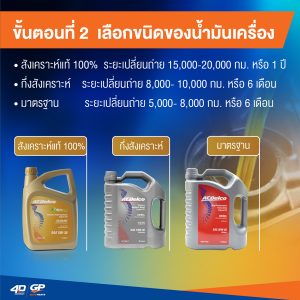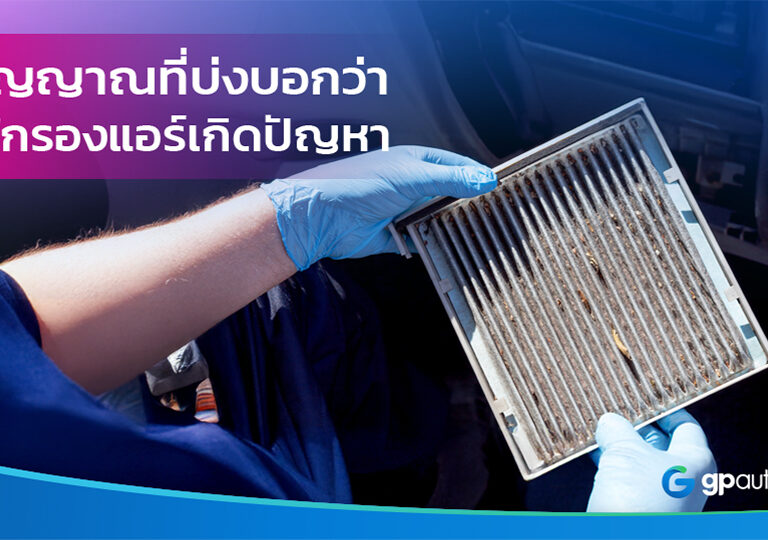Engine oil serves the purpose of lubricating various components.
Today, G.P.Auto Parts will take you through “Choosing the Right Engine Oil for You and Your Car in 4 Steps,” considering the movement within the engine system, such as pistons, crankshafts, to enhance driving performance, prevent engine wear, and extend engine lifespan.

Step 1: Choose the type of engine oil
Generally, there are two main types: gasoline (petrol) and diesel. Each car will have specifications in the owner’s manual indicating which type of engine oil should be used.
It is highly recommended to use the correct type of engine oil that matches your engine for optimal performance. Using the wrong type of oil can cause engine wear and damage. Typically, the type of oil will be indicated on the label:
– For gasoline engines, it is generally labeled as “Gasoline.”
– For diesel engines, it is typically labeled as “Diesel.”

Step 2: Choose the Type of Engine Oil
Engine oils are divided into 3 types:
1. Fully Synthetic: This type of engine oil is 100% synthetic and offers the longest service life. It enhances engine performance, withstands high temperatures well, prevents sludge buildup, and saves fuel. Suitable for daily use and for those with limited time for maintenance. Change interval: 15,000-20,000 kilometers or 1 year.
2. Semi-Synthetic: Semi-synthetic engine oil is a blend of synthetic and conventional base oils. It offers moderate service life and is suitable for applications with moderate change intervals. Change interval: 8,000-10,000 kilometers or 6 months.
3. Conventional: Conventional engine oil is the most cost-effective but has the shortest service life. It is designed for heavy-duty engines such as trucks, buses, and pickups. Change interval: 5,000-8,000 kilometers or 6 months.

Step 3: Choose the Oil Viscosity
Oil viscosity refers to the thickness of the engine oil. If the oil is too thick or too thin, it won’t circulate and lubricate the engine properly, leading to engine wear and tear.
You can determine oil viscosity from the letter “W,” followed by a number. Here’s what it means:
The number before “W” indicates the oil viscosity at low temperatures or when the engine is cold. A lower number indicates lower viscosity, which allows for better engine lubrication when cold.
The number after “W” indicates the oil viscosity at high temperatures or when the engine is running. A higher number indicates higher viscosity, which provides better lubrication and engine protection during operation, such as 30, 40, 50, or 60. This is measured at 100 degrees Celsius.
For home use, you can mainly focus on the number after “W.” Consult your car’s manual to determine the recommended viscosity.
Different types of vehicles require different viscosity levels:
For newer vehicles with mileage under 200,000 kilometers, choose oil with lower viscosity, such as 30.
For older vehicles with mileage over 200,000 kilometers, choose oil with higher viscosity, such as 40 or 50

Step 4: Choose the Oil Standards
Oil standards refer to the quality grades of engine oil, and there are several organizations that establish these standards, including JASO (Japanese Automotive Standard Organization), SAE (Society of Automotive Engineers), and API (American Petroleum Institute).
In Thailand, the most commonly used standard is from the API, which stands for the American Petroleum Institute, or “สถาบันปิโตรเรียมอเมริกา” in Thai.
Currently, the highest standard is the Dexos standard, which is exclusively certified for fully synthetic oils. It is a proprietary standard developed by General Motors (GM) and engineered by the GM Global Powertrain team. Dexos combines the latest standards from leading institutions in the United States and Europe, such as API and ACEA. This helps extend the oil change interval by up to twice as long as conventional fully synthetic oils, thanks to the Engine Oil Life System (EOLS) technology.
For oils seeking to meet the Dexos standard, a license must be purchased from General Motors (GM). Only then can the Dexos symbol be displayed on the product label. This symbol indicates that the engine oil meets the Dexos standard.
.
For the ACDelco engine oil brand, produced directly by General Motors (GM), it must adhere to the dexos standard when used in genuine synthetic engine oil grades. Not only does it meet the standard, but it also has a special formula that exceeds the general standards. You can easily identify this by the symbol on the front label. ✨
___________________________________
Place an order/Become a distributor.
GP MOBILITY PUBLIC COMPANY LIMITED
Line id: @gpautoparts or Link
Contact: https://www.gpmobility.co.th/contact-us/
Follow me: https://linktr.ee/gpmobility
Service Monday to Saturday from 08:30 AM to 05:30 PM.
02-941-1222 (Auto),02-579-2882











